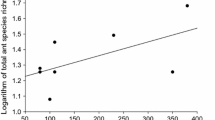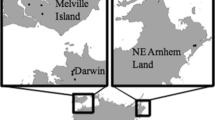Abstract
Southern California’s sage scrub (SS) ecosystem is severely threatened by suburban development and invasion by non-native grasses, but how these threats impact the arthropod community is poorly understood. Native ants, which face the additional threat of being displaced by non-native Argentine ants, may be particularly at risk of local and regional extirpation. In this study, we surveyed the ant communities in the SS and non-native grassland habitats at the Robert J Bernard Biological Field Station (BFS) and surrounding suburban habitat, and compared patterns of species richness and composition among habitat types. We also compared ant richness and composition at the BFS to 40 coastal SS fragments previously surveyed in San Diego County to better understand how ant communities in interior and coastal SS fragments differ. Ant composition significantly differed among all three habitat types at and surrounding the BFS, but species richness did not. Comparisons between the BFS and coastal fragments indicate that interior SS fragments harbor unique ant species and more species relative to fragment area. Increased richness and unique ant assemblages are probably associated with the limited ability of invasive Argentine ants to colonize the non-native grassland and SS at the BFS. Because many southern California invertebrates are narrowly endemic to low elevation areas, patterns of habitat specificity seen with ants highlight that maintaining a mosaic of SS and non-native grassland habitat, particularly in interior areas where activity and diversity of non-native invertebrate species may be restricted, may be critical to preserving biodiversity.




Similar content being viewed by others
References
Alberts AC, Richman AD, Tran D, Sauvajot R, McCalvin C, Bolger DT (1993) Effects of habitat fragmentation on populations of native and exotic plants in southern California coastal scrub. In: Keely JE (ed) Interface between ecology and land development in California. Southern California Academy of Science, Los Angeles, pp 103–110
AntWeb (2015). Available from http://www.antweb.org. Accessed 19 June 2015
Bolger DT (2007) Spatial and temporal variation in the Argentine ant edge effect: implications for the mechanism of edge limitation. Biol Conserv 136:295–305
Bolger DT, Suarez AV, Crooks KR, Morrison SA, Case TJ (2000) Arthropods in urban habitat fragments in Southern California: area, age, and edge effects. Ecol Appl 10:1230–1248
Bolger DT, Beard KH, Suarez AV, Case TJ (2008) Increased abundance of native and non-native spiders with habitat fragmentation. Divers Distrib 14:655–665
Branstetter MG (2012) Origin and diversification of the cryptic ant genus Stenamma Westwood (Hymenoptera: Formicidae), inferred from multilocus molecular data, biogeography, and natural history. Syst Entomol 37:478–496
Clarke KR, Gorley RN (2006) PRIMER v6: user manual/tutorial. Plymouth, PRIMER-E
Clary J, Savé R, Biel C, De Herralde F (2004) Water relations in competitive interactions of Mediterranean grasses and shrubs. Ann Appl Biol 144:149–155
Colwell RK, Mao CX, Chang J (2004) Interpolating, extrapolating, and comparing incidence-based species accumulation curves. Ecology 85:2717–2727
Cowling RM, Rundel PW, Lamont BB, Arroyo MK, Arianoutsou M (1996) Plant diversity in Mediterranean-climate regions. Trends Ecol Evolut 11:362–366
Cox RL, Underwood EC (2011) The importance of conserving biodiversity outside of protected areas in Mediterranean ecosystems. PLoS One 6:e14508
Cox RD, Preston KL, Johnson RF, Minnich RA, Allen EB (2014) Influence of landscape-scale variables on vegetation conversion to exotic annual grassland in southern California, USA. Glob Ecol Conserv 2:190–203
D’Antonio CM, Vitousek PM (1992) Biological invasions by exotic grasses, the grass/fire cycle, and global change. Annu Rev Ecol Syst 23:63–87
DeSimone SA, Zedler PH (2001) Do shrub colonizers of southern California grassland fit generalities for other woodly colonizers? Ecol Appl 11:1101–1111
Eliason SA, Allen EB (1997) Exotic grass competition in suppressing native shrubland re-establishment. Restor Ecol 5:245–255
Goldstein LJ, Suding KN (2014) Intra-annual rainfall regime shifts competitive interactions between coastal sage scrub and invasive grasses. Ecology 95:425–435
Higgins JW (2010) Ground dwelling arthropod responses to successional endpoints: burned versus old growth pinyon-juniper woodlands. MA thesis, Northern Arizona University, USA
Hogue CL (1993) Insects of the Los Angeles basin, 2nd edn. Natural History Museum of Los Angeles, Los Angeles
Holway DA, Suarez AV, Case TJ (2002) Role of abiotic factors in governing susceptibility to invasion: a test with Argentine ants. Ecology 83:1610–1619
Human KG, Weiss S, Weiss A, Sandler B, Gordon DM (1998) Effects of abiotic factors on the distribution and activity of the invasive Argentine ant (Hymenoptera: Formicidae). Environ Entomol 27:822–833
Keaton WT (1960) A taxonomic study of the millipede family Spirobolidae (Diplopoda: Spirobolida). Mem Am Entomol Soc 17:1–146
Keeley JE, Baer-Keeley M, Fotheringham CJ (2005) Alien plant dynamics following fire in Mediterranean-climate California shrublands. Ecol Appl 15:2109–2125
Kimball S, Goulden ML, Suding KN, Parker S (2014) Altered water and nitrogen input shifts succession in a southern California coastal sage community. Ecol Appl 24:1390–1404
Küchler AW (1977) The map of the natural vegetation of California. In: Barbour MJ, Major J (eds) Terrestrial vegetation of California. Wiley, New York, pp 909–938
Legendre L, Legendre P (1983) Numerical ecology. Elsevier Scientific, New York, New York
Matsuda T, Turschak G, Brehme C, Rochester C, Mitrovich M, Fisher R (2011) Effects of large-scale wildfires on ground foraging ants (Hymenoptera: Formicidae) in Southern California. Environ Entomol 40:204–216
Medail F, Quezel P (1997) Hot-spots analysis for conservation of plant biodiversity in the Mediterranean basin. Ann Mo Bot Gard 84:112–127
Menke SB, Holway DA (2006) Abiotic factors control invasion by Argentine ants at the community scale. J Anim Ecol 75:368–376
Minnich RA (2008) California’s fading wildflowers: lost legacy and biological invasions. University of California Press, Berkeley
Minnich RA, Dezzani RJ (1998) Historical decline of coastal sage scrub in the Riverside-Perris Plain, California. Western Birds 29:366–391
Mooney HA (1977) Southern coastal scrub. In: Barbour MG, Major J (eds) Terrestrial vegetation of California. Wiley, New York, pp 471–489
Pilsbry HA (1939) Land mollusca of North America north of Mexico. Volume 1, Part 1. Academy of Natural Sciences of Philadelphia, Philadelphia, USA
Riordan EC, Rundel PW (2009) Modelling the distribution of a threatened habitat: the California sage scrub. J Biogeogr 36:2176–2188
Riordan EC, Rundel PW (2014) Land use compounds habitat losses under projected climate change in a threatened California ecosystem. PLoS One 9:e86487
Roth BA, Sadeghian P (2003) Check list of the land snails and slugs of California. Santa Barbara Museum of Natural History Contributions in Sciences, no. 3., Santa Barbara, CA. USA
Rundel PW (2007) Sage scrub. In: Barbour MG, Keeler Wolf T, Schoenherr AA (eds) Terrestrial vegetation of California. University of California Press, Berkeley, pp 208–228
Sala OS, Chapin FS III, Armesto JJ, Berlow E, Bloomfield J, Dirzo R, Huber-Sannwald E, Huenneke LF, Jackson RB, Kinzig A, Leemans R, Lodge DM, Mooney HA, Oesterheld M, Poff NL, Sykes MT, Walker BH, Walker M, Wall DH (2000) Global biodiversity scenarios for the year 2100. Science 287:1770–1774
Soulé ME, Bolger DT, Alberts AC, Sauvajot R, Wright J, Sorice M, Hill S (1988) Reconstructed dynamics of rapid extinction of chaparral requiring birds in urban habitat islands. Conserv Biol 2:75–92
Suarez AV, Bolger DT, Case TJ (1998) Effects of fragmentation and invasion on native ant communities in coastal Southern California. Ecology 79:2041–2056
Talluto MV, Suding KN (2008) Historical change in coastal sage scrub in Southern Californica, USA in relation to fire frequency and air pollution. Landsc Ecol 23:803–815
Tillberg CV, Holway DA, LeBrun EG, Suarez AV (2007) Trophic ecology of Argentine ants in their native and introduced ranges. PNAS 104:20856–20861
Underwood EC, Viers JH, Klausmeyer KR, Cox RL, Shaw MR (2009) Threats and biodiversity in the Mediterranean biome. Divers Distrib 15:188–197
Ward PS (1987) Distribution of the introduced Argentine ant (Iridomyrmex humilis) in natural habitats of the lower Sacramento Valley and its effects on the indigenous ant fauna. Hilgardia 55:1–16
Ward PS (2005) A synoptic review of the ants of California (Hymenoptera: Formicidae). Zootaxa 936:1–68
Westman WE (1981) Diversity relations and succession in Californian coastal sage scrub. Ecology 62:170–184
Wolkovich EM, Bolger DT, Holway DA (2009a) Complex responses to invasive grass litter by ground arthropods in a Mediterranean scrub ecosystem. Oecologia 161:697–708
Wolkovich EM, Bolger DT, Cottingham KL (2009b) Invasive grass litter facilitates native shrubs through abiotic effects. J Veg Sci 20:1121–1131
Wolkovich EM, Lipson DA, Virginia RA, Cottingham KA, Bolger DT (2010) Grass invasion causes rapid increases in ecosystem carbon and nitrogen storage in a semiarid shrubland. Glob Change Biol 16:1351–1365
Acknowledgments
This study was made possible by funding from the Howard Hughes Medical Institute’s 2012 Colleges Initiative (HHMI Grant #52007555) and the Department of Biology at Pomona College and was conducted with permission by the Claremont Colleges’ Robert J. Bernard Field Station. We would like to thank Nina Karnovsky for reviewing earlier versions of this manuscript and Kim Franklin who helped with species identification. Phil Ward and Matthew Prebus provided access to the voucher specimens deposited by Andrew Suarez at the Bohart Museum of Entomology at the University of California, Davis. The authors are grateful to Ashish Streatfield, Kristen Park, Taylor Montgomery, Jeanette Rios, Brenna Gormally and Madeline Bossi for help setting up pitfall traps and processing trap contents.
Author information
Authors and Affiliations
Corresponding author
Electronic supplementary material
Below is the link to the electronic supplementary material.
Rights and permissions
About this article
Cite this article
Staubus, W.J., Boyd, E.S., Adams, T.A. et al. Ant communities in native sage scrub, non-native grassland, and suburban habitats in Los Angeles County, USA: conservation implications. J Insect Conserv 19, 669–680 (2015). https://doi.org/10.1007/s10841-015-9790-5
Received:
Accepted:
Published:
Issue Date:
DOI: https://doi.org/10.1007/s10841-015-9790-5




